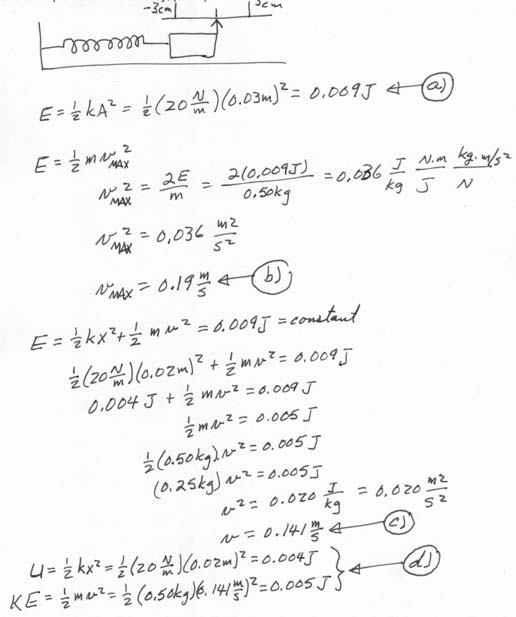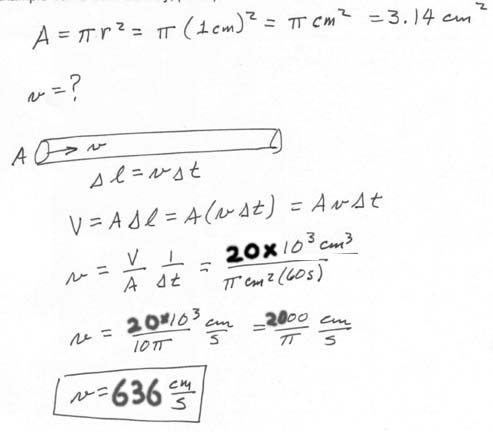

PHY 1351
Fall 2001
Fourth Hour Exam
5 December 2001
1. A uniform ladder of length L and weight w = 50 N rests against a smooth, frictionless, vertical wall. If the coefficient of static friction between ladder and ground is µs = 0.40, find the minimum angle theta(min) such that the ladder does not slip. (This is Example 12.4 from Serway, page 344).
Don't even begin without a good force diagram! Diagrams really are important.
When we calculate the torques, I have chosen our origin as the foot of the ladder:
It seemed to be very easy to interchange sine and cosine. Always start from the diagram and remember that
torque = (dist) x (force) x sin(theta)
where (theta) is the angle between the distance and the force.
2. A 0.50 kg mass connected to a light spring of force constant 20.0
N/m oscillates on a horizontal, frictionless track.
(a) Calculate the total energy of the system if the amplitude of the motion
is 3.0 cm ( 0.03 m).
(b) Calculate the maximum speed of the mass if the amplitude of the motion is
3.0 cm ( 0.03 m).
(c) What is the speed of the mass when the displacement is 2.0 cm (0.02 m)?
(d) What are the kinetic and potential energies of the system when the displacement
is 2.0 cm (0.02 m)?
(d1) What is the kinetic energy of the system when the displacement
is 2.0 cm (0.02 m)?
(d2) What is the potential energy of the system when the displacement
is 2.0 cm (0.02 m)?
(This is Example 13.5 from Serway, p 369)

A geosynchronous satellite has a period of 24 hours.
Show all your work and calculate the orbital radius of a geosynchronous
satellite.
(This was done in class).
This turned out to be a poor problem.
What I intended was that you would start by setting the centripetal force equal to the gravitational force and, from that, deriving Kepler's Third Law,
However, I forgot that I had already included this last equation on the front equation sheet. So all the real Physics work was already done for you. Now, it is just an arithmetic evaluation problem.
Be sure to convert the period from hours into seconds;
This question began by stating that r = 42,200 km. However, many solutions then evaluated r and found a drastically different value for r. I do not understand that!
1 cm3 = 1 mL = 0.001 L
1 L = 103 cm3
(This is Example 15.12 from Serway, p 433).
This is barely a Physics problem at all. It's more a question of simple geometry or ordinary reasoning. It is a Physics problem only in that we use these ideas -- like the equation of continuity -- in fluid flow. I will try to have a more "robust" problem from fluids on the final!

Conceptual Questions:
1. Describe qualitatively the motion of a mass-spring system when the mass of the spring is not neglected.
When we made measurements in the lab we could not neglect the mass of the spring. There, we included the mass of the spring by adding one-third of the spring's mass to the "ordinary mass" that we had used in theory or in lecture. That meant that the "real mass" or the "effective mass" was greater than we had used in the lecture. This gave a longer period.
2. What happens to the period of a simple pendulum if the mass of the bob is doubled?
For a pendulum, the period is independent of the mass so there is no change in the period.[Note, of course, that this is quite different for a "spring-and-mass" simple harmonic oscillator.]
3. Does the escape speed of a rocket depend on its mass?
No, when we derived an expression for the escape speed, it did not include the mass of the rocket.
4.Why don't we put a geosynchronous weather satellite in orbit around the 45th parallel? Wouldn't this be more useful to the United States than such a satellite in orbit around the equator?
The force of gravity due to Earth is exerted toward the center of Earth. That means the plane of any orbit around Earth must include the center of the Earth.
5. Does a ship ride higher in the water of an inland lake or in the ocean?To float, a ship must displace a volume of water that has as much weight as the weight of the ship. Sea water has a greater density than fresh water so less sea water must be displaced. This means the ship will ride higher in the ocean.